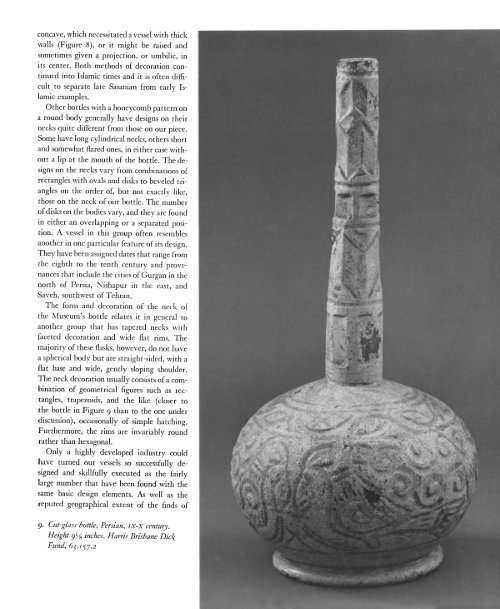Islamic Art: The Metropolitan Museum of Art Bulletin, v. 23, no. 6 ...
Islamic Art: The Metropolitan Museum of Art Bulletin, v. 23, no. 6 ...
Islamic Art: The Metropolitan Museum of Art Bulletin, v. 23, no. 6 ...
You also want an ePaper? Increase the reach of your titles
YUMPU automatically turns print PDFs into web optimized ePapers that Google loves.
concave, which necessitated a vessel with thick<br />
walls (Figure 8), or it might be raised and<br />
sometimes given a projection, or umbilic, in<br />
its center. Both methods <strong>of</strong> decoration continued<br />
into <strong>Islamic</strong> times and it is <strong>of</strong>ten difficult<br />
to separate late Sasanian from early <strong>Islamic</strong><br />
examples.<br />
Other bottles with a honeycomb pattern on<br />
a round body generally have designs on their<br />
necks quite different from those on our piece.<br />
Some have long cylindrical necks, others short<br />
and somewhat flared ones, in either case without<br />
a lip at the mouth <strong>of</strong> the bottle. <strong>The</strong> designs<br />
on the necks vary from combinations <strong>of</strong><br />
rectangles with ovals and disks to beveled triangles<br />
on the order <strong>of</strong>, but <strong>no</strong>t exactly like,<br />
those on the neck <strong>of</strong> our bottle. <strong>The</strong> number<br />
<strong>of</strong> disks on the bodies vary, and they are found<br />
in either an overlapping or a separated position.<br />
A vessel in this group <strong>of</strong>ten resembles<br />
a<strong>no</strong>ther in one particular feature <strong>of</strong> its design.<br />
<strong>The</strong>y have been assigned dates that range from<br />
the eighth to the tenth century and provenances<br />
that include the cities <strong>of</strong> Gurgan in the<br />
<strong>no</strong>rth <strong>of</strong> Persia, Nishapur in the east, and<br />
Saveh, southwest <strong>of</strong> Tehran.<br />
<strong>The</strong> form and decoration <strong>of</strong> the neck <strong>of</strong><br />
the <strong>Museum</strong>'s bottle relates it in general to<br />
a<strong>no</strong>ther group that has tapered necks with<br />
faceted decoration and wide flat rims. <strong>The</strong><br />
majority <strong>of</strong> these flasks, however, do <strong>no</strong>t have<br />
a spherical body but are straight-sided, with a<br />
flat base and wide, gently sloping shoulder.<br />
<strong>The</strong> neck decoration usually consists <strong>of</strong> a combination<br />
<strong>of</strong> geometrical figures such as rectangles,<br />
trapezoids, and the like (closer to<br />
the bottle in Figure 9 than to the one under<br />
discussion), occasionally <strong>of</strong> simple hatching.<br />
Furthermore, the rims are invariably round<br />
rather than hexagonal.<br />
Only a highly developed industry could<br />
have turned out vessels so successfully de-<br />
signed and skillfully executed as the fairly<br />
large number that have been found with the<br />
same basic design elements. As well as the<br />
reputed geographical extent <strong>of</strong> the finds <strong>of</strong><br />
9. Cut-glass bottle, Persian, ix-x century.<br />
Height 98 inches. Harris Brisbane Dick<br />
Fund, 63.I57.2

















